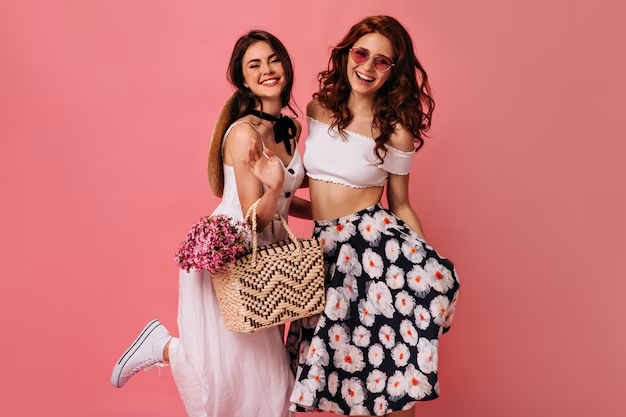How Social Media is Shaping the Future of Fashion
Social media has transformed many industries, and one of the most prominent sectors influenced by this digital revolution is fashion. With platforms like Instagram, TikTok, Pinterest, and YouTube, social media has become a powerful tool in shaping the future of fashion by altering how trends emerge, how brands interact with consumers, and how individuals express their identities. Here’s how social media is influencing the fashion industry:
1. Accelerating Trend Cycles
- Instantaneous Trend Discovery: Social media has compressed traditional fashion cycles. What once took months (or even years) to become mainstream can now spread worldwide within days, thanks to the rapid sharing of content. Platforms like Instagram and TikTok allow influencers, designers, and everyday users to share and popularize trends, making fashion more dynamic and fast-paced.
- Micro-Trends: Social media also facilitates the rise of micro-trends, which are short-lived but highly influential. These trends can emerge from niche communities or viral moments, such as specific hashtags or challenges (e.g., #OOTD or #DressingForTheGram). As a result, fashion is now moving away from the traditional seasons and embracing quicker, more reactive cycles.
2. Empowering Influencers and Content Creators
- Rise of Fashion Influencers: Social media has democratized fashion, allowing influencers, bloggers, and creators to rise to fame and become key figures in fashion marketing. Platforms like Instagram and TikTok provide an accessible space for individuals to share their personal style, which has led to the rise of influencer-driven fashion marketing. Brands now collaborate with influencers to reach specific audiences, often bypassing traditional advertising methods.
- Authenticity and Relatability: Consumers are increasingly drawn to influencers and content creators who feel more relatable and authentic. Influencers who share their real-life fashion choices, behind-the-scenes looks, or sustainability practices are gaining traction over those who only promote idealized lifestyles. This shift is changing how fashion is marketed, with brands now prioritizing influencers who have a genuine connection with their followers.
3. Shaping Consumer Behavior
- Direct-to-Consumer Marketing: Social media platforms have become a direct channel for brands to reach their audience, allowing consumers to shop instantly. The integration of shopping features on Instagram, Pinterest, and TikTok means that users can go from discovering a product to purchasing it in seconds. This “shop now” feature has made impulse buying more common and accessible.
- User-Generated Content (UGC): Fashion brands are encouraging consumers to create and share content that features their products, which is then used in marketing campaigns. This shift to UGC allows brands to appear more authentic and create a sense of community around their products. Hashtags, challenges, and collaborations also incentivize fans to engage with brands in creative ways.
4. Promoting Diversity and Inclusivity
- Inclusive Representation: Social media has pushed for greater diversity in fashion representation. Previously underrepresented groups, including people of different body sizes, ethnicities, and gender identities, are finding a voice on platforms like Instagram and TikTok. Fashion brands are now more likely to feature a diverse range of models and collaborate with influencers who represent different walks of life.
- Body Positivity: Movements like body positivity and self-love, fueled by social media, have influenced how people approach fashion. Many users are now rejecting traditional beauty standards and embracing diverse body types, leading to increased demand for plus-size fashion and more inclusive sizing options. Social media has created a space where people feel empowered to dress how they want without adhering to restrictive norms.
5. Impact on Sustainability and Ethical Fashion
- Conscious Consumerism: Social media has helped raise awareness about the environmental and social impact of fashion. Influencers and activists are using platforms to promote sustainable fashion brands, second-hand shopping, upcycling, and ethical production practices. As a result, more consumers are becoming conscious of their buying habits and are prioritizing brands that align with their values.
- Transparency and Accountability: Social media has also created a demand for transparency in the fashion industry. Consumers now have the ability to directly engage with brands through comments, direct messages, and reviews. If a company is found to be unethical or unsustainable, social media can amplify these concerns, pressuring brands to adopt more responsible practices.
6. Virtual Fashion and Augmented Reality
- Digital Fashion: As social media platforms evolve, so does the concept of digital fashion. With the rise of virtual influencers (like Lil Miquela) and fashion shows hosted in virtual environments, the idea of “wearing” clothes in digital spaces is gaining popularity. For example, some fashion brands are creating virtual clothing that can be worn by users in photos or on avatars in video games.
- Augmented Reality (AR): Social media platforms are integrating AR features that allow users to virtually try on clothes and accessories. Instagram and Snapchat, for example, offer AR filters where users can see how certain clothes or makeup will look on them before making a purchase. This immersive technology is redefining the way consumers interact with fashion and is shaping the future of online shopping.
7. Shifting Fashion Consumption
- Fast Fashion and Instant Gratification: Social media has also contributed to the rise of fast fashion, where brands produce high volumes of affordable clothing in response to trending styles seen on social platforms. While this provides consumers with quick access to the latest styles, it has also sparked conversations about the environmental and ethical implications of overconsumption.
- Second-Hand and Resale Culture: Platforms like Depop, Poshmark, and ThredUp have gained popularity in part due to the influence of social media, where the idea of sustainable fashion is tied to buying pre-owned items. This resale culture is changing how consumers perceive fashion ownership and is fostering a new generation of eco-conscious shoppers.
8. Shaping Fashion Events and Shows
- Digital Fashion Shows: With the rise of virtual experiences, many fashion brands and designers are shifting away from traditional in-person fashion shows and opting for digital presentations. Fashion shows streamed on platforms like Instagram Live, TikTok, or YouTube reach a global audience and are often more accessible than traditional runway shows. Brands are also incorporating interactive elements, allowing viewers to engage with the show in real-time.
- Influencers at Fashion Week: Social media influencers now play a key role in fashion week events. Influencers and content creators attend major fashion shows, sharing their experiences with their followers, thus offering a more behind-the-scenes and authentic look at the fashion industry. Their presence helps bring attention to designers and collections that might otherwise be overlooked.
Conclusion
Social media is undeniably shaping the future of fashion by changing how trends are discovered, how brands engage with consumers, and how people express their personal style. It has introduced a new era of inclusivity, rapid trends, and direct consumer engagement, making fashion more accessible, diverse, and dynamic. As technology continues to evolve, the role of social media in fashion will only grow, leading to even more innovative and transformative changes in the industry.

